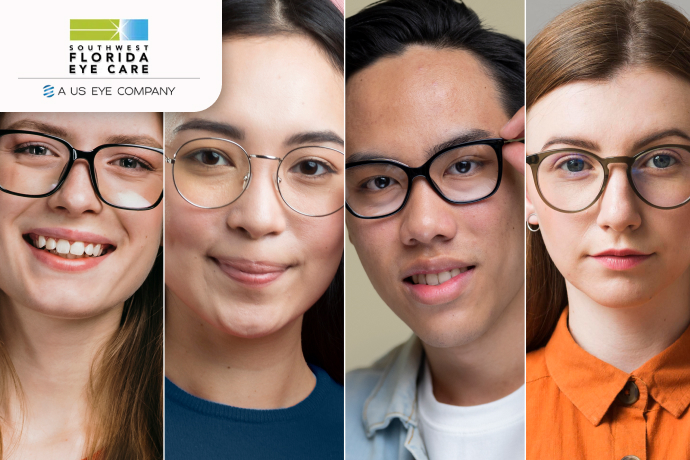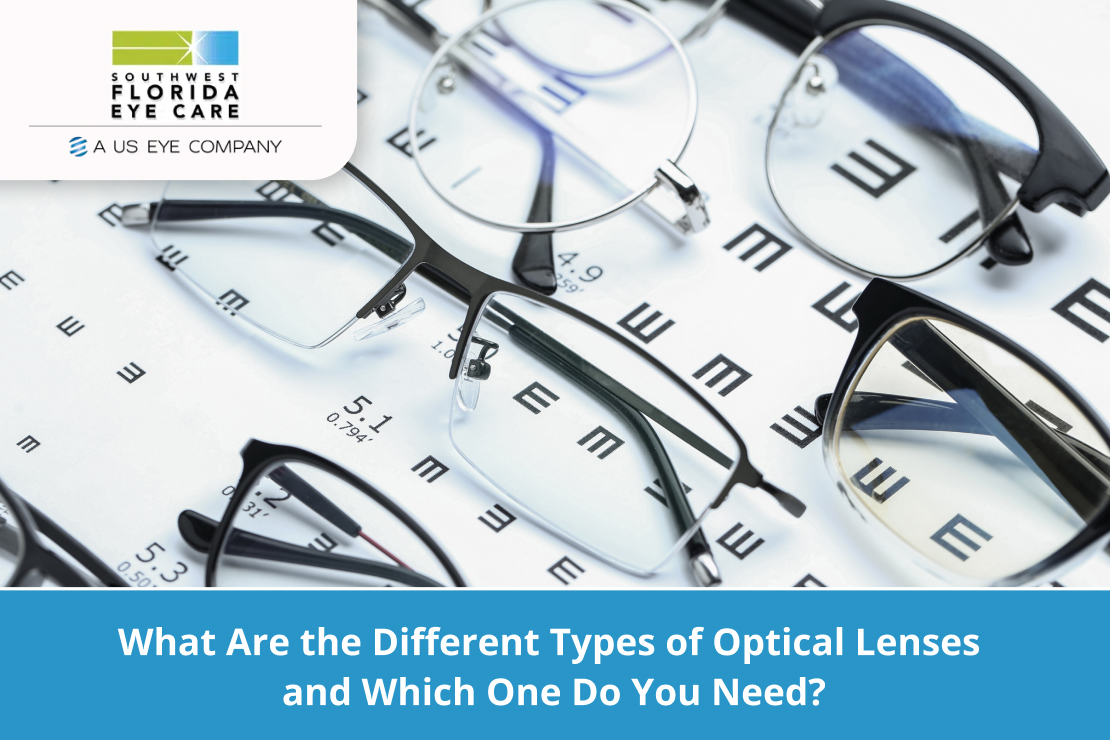Nearly 60% of US adults wear glasses or contacts, and over 80% of people over 40 deal with presbyopia, meaning they need help reading close up. Yet only a small fraction of this population understands the types of optical lenses they’re using. Most follow the optician’s pick without asking why.
On the flip side, LASIK isn’t that rare, with more than 700,000 procedures per year in the US alone, with roughly 96% of patients achieving 20/20 vision or better and satisfaction rates near 96%. So if you’ve ever squinted at a screen for too long, fumbled with your glasses while switching from sunlight to indoors, or just wondered if there’s a better, sharper, more comfortable way to correct your vision, this is for you.
Let’s break down the fundamental differences between the types of optical lenses, what each one is built to do, and how eye surgery fits into the picture. And by the end, you’ll know different paths that are available for your eye health.
First, Know Your Prescription
Before we break down lens types, it’s important to understand the numbers your eye doctor gives you.
Your eyeglass prescription includes:
- Sphere (SPH): For nearsightedness or farsightedness
- Cylinder (CYL): For astigmatism
- Axis: The orientation of the astigmatism
- Add: For reading (common after age 40)
Knowing this helps you choose the right type of optical lens. It also helps your provider determine if you’re a candidate for LASIK eye surgery—a long-term option for many.
Step-by-Step: Understand the Lens Material First
Before we even talk about shape or function, let’s look at what the lenses are made of. Material affects comfort, thickness, weight, and clarity.
1. Plastic (CR-39) Lenses
- Most common.
- Affordable and lightweight.
- Good optical clarity for basic prescriptions.
2. Polycarbonate Lenses
- Stronger than plastic.
- Impact-resistant. Ideal for kids, athletes, or safety glasses.
- Includes UV protection by default.
3. Trivex Lenses
- Lightweight and durable like polycarbonate.
- Better optical clarity.
- Suitable for moderate prescriptions.
4. High-Index Plastic Lenses
- Much thinner and lighter.
- Designed for people with strong prescriptions.
- Improves aesthetics and comfort.
5. Glass Lenses (rare today)
- Superior clarity, but heavy and breakable.
- Although used for specialty lenses, it is not ideal for everyday use.
If you wear your glasses all day, every day, material choice matters.

Types of Optical Lenses (Designs That Fit Your Vision)
Now that we’ve covered material, let’s talk about lens design and what each one does. Here are the eight main types of optical lenses:
1. Single Vision Lenses
- One consistent power across the entire lens.
- Used for either nearsightedness or farsightedness.
- Ideal for individuals under 40 who require only one correction type.
This is the most common type of optical lens for everyday wear.
2. Bifocal Lenses
- Two lens powers—top for distance, bottom for reading.
- Visible line between the two sections.
- Designed for presbyopia, which is common after 40.
3. Trifocal Lenses
- Adds a third section in the middle for computer or arm’s length tasks.
- Top: Distance | Middle: Intermediate | Bottom: Reading.
- Often used by professionals and seniors.
4. Progressive Lenses (No-Line Multifocals)
- Like trifocals, but without visible lines.
- Smooth transition between all distances.
- Excellent for full-time wearers who don’t want the look of bifocals.
Note: Not everyone adjusts easily to progressives—proper fitting matters.
5. Photochromic Lenses
- Automatically darken outdoors and clear up indoors.
- Popular with those who don’t want to carry sunglasses.
These are available in most types of optical lenses, including single vision and progressives.
6. Polarized Lenses
- Reduce glare, especially from water, glass, or pavement.
- Best for outdoor use, driving, boating, or fishing.
7. Computer/Blue-Light Lenses
- Designed for screen use.
- Helps reduce digital eye strain by enhancing focus range and filtering some blue light.
These are NOT a replacement for regular vision correction, but can be added to prescription lenses.
8. Aspheric Lenses
- Flatter curve than traditional lenses.
- Reduces distortion and makes glasses look thinner.
Lens Coatings That Matter
Whatever type of optical lens you choose, add-ons can make a huge difference:
- Anti-Reflective Coating (AR): Cuts glare, improves clarity.
- Scratch-Resistant Coating: Protects your investment.
- UV Protection Coating: Essential in Florida sun.
- Blue Light Filter: Optional for screen-heavy users.
- Hydrophobic/Anti-Smudge Coating: Great for extended wear.
Adding coatings often costs a little more, but they extend the life and performance of your lenses.
LASIK Eye Surgery vs. Optical Lenses
Now, let’s look at LASIK eye surgery as an alternative. Here’s what you should know:
- LASIK reshapes your cornea with a laser to correct vision permanently.
- It’s suitable for correcting nearsightedness, farsightedness, and astigmatism.
- Many patients stop needing glasses or contacts afterward.
- Presbyopia (age-related near vision loss) may still require reading glasses later in life.
- A complete exam can determine if LASIK is right for you.
Why it matters: Understanding your current types of optical lenses can help you weigh if LASIK eye surgery is worth exploring.
Thinking about LASIK but nervous about what it feels like? That’s normal. We covered everything you need to know, including what to expect during the procedure, and how it feels, in our guide.
Match Lens to Lifestyle: What Should You Choose?
| Lifestyle | Best Lens Type | Why |
| Basic vision correction | Single Vision Lenses | Simple, low-cost, clear vision |
| Age-related near vision loss | Bifocal or Progressive Lenses | Corrects both distance and near |
| Computer-heavy work | Computer Lenses or Blue Light | Reduces screen strain and glare |
| Strong prescriptions | High-Index or Aspheric Lenses | Slimmer, lighter, more comfortable |
| Outdoor or sporty lifestyle | Polarized or Photochromic Lenses | UV protection + glare control |
| Want to ditch glasses entirely | LASIK Eye Surgery | Long-term freedom from lenses |
Why Choose Southwest Florida Eye Care?
When it comes to something as sensitive and vital as your vision, you need a provider who does more than hand you a prescription.
At Southwest Florida Eye Care, we offer:
- Comprehensive eye exams and surgical care, including laser eye surgery evaluations.
- Decades of experience serving the Southwest Florida community since 2003.
- State-of-the-art equipment for precise diagnostics and treatment.
- A full designer optical boutique for high-quality lenses and frames.
Whether you’re exploring new types of optical lenses or ready to see if eye surgery is right for you, we’re here to guide you step by step.
Let’s Talk About Your Eyes
Using the wrong lenses isn’t just annoying; it can be expensive, uncomfortable, and hinder your ability to see clearly. In 2017, an estimated 12 million adults 40 years or older in the U.S. had visual impairment that affects daily life, yet many stick with ill-fitting correction options.
But it doesn’t have to stay that way. With multiple lens types (single vision, bi-, tri-, and progressive) plus innovative coatings and materials like high‑index and polycarbonate, you can tailor your vision correction to how you live.
At Southwest Florida Eye Care, we believe in matching the right solution, not the most expensive one. We’ve been serving Southwest Florida since 2003, and we know that your eyes deserve answers.
So what matters to you most? Is it comfort? Freedom? Sharper vision every day? Let’s talk about it.
Contact us to schedule your exam to discuss whether lens options or LASIK eye surgery is the better route for your lifestyle and eyesight. Your vision is too crucial for assumptions.
Frequently Asked Questions
What are the main types of optical lenses available for glasses?
There are several main types of optical lenses, each designed for specific vision needs:
- Single vision lenses (for one correction, such as nearsightedness or farsightedness)
- Bifocal lenses (two sections for distance and reading)
- Trifocal lenses (three sections: distance, intermediate, and near)
- Progressive lenses (smooth transition between multiple distances, no visible lines)
- Photochromic lenses (darken outdoors, clear indoors)
- Polarized lenses (reduce glare, ideal for outdoor use)
- Computer/blue-light lenses (help reduce digital eye strain)
- Aspheric lenses (thinner, flatter, less distortion)
How do I know which type of lens is right for my prescription?
The right lens depends on your prescription details and lifestyle. For example, single vision lenses are great for basic correction, while progressives or bifocals are better for age-related near vision loss. If you have a strong prescription, high-index or aspheric lenses may be more comfortable. Your eye doctor can help match your needs to the best lens design.
What’s the difference between bifocal, trifocal, and progressive lenses?
Bifocal lenses have two distinct sections (distance and near), trifocal lenses add a middle section for intermediate tasks, and progressive lenses offer a seamless transition between multiple vision zones without visible lines. Progressives are more discreet but can take some time to get used to.
Are lens coatings worth the extra cost?
Yes, coatings can significantly improve lens performance and lifespan. Popular options include anti-reflective (AR) coating (reduces glare), scratch resistance (protects from daily wear), UV protection (shields eyes from harmful rays), and blue light filters (minimize digital eye strain). Investing in coatings can make your glasses more comfortable and durable.
What is the difference between polycarbonate, high-index, and regular plastic lenses?
Polycarbonate lenses are impact-resistant and lightweight, making them ideal for children, athletes, or safety glasses. High-index lenses are thinner and lighter than standard plastic, perfect for strong prescriptions. Regular plastic (CR-39) lenses are affordable and offer good clarity for basic needs.
Can I get blue light protection in my prescription lenses?
Absolutely. Blue light protection can be added as a coating or built into specific lenses. It’s helpful if you spend long hours on digital devices, as it can reduce eye strain and may help with sleep quality.
What are photochromic lenses, and who should consider them?
Photochromic lenses automatically darken in sunlight and return to clear indoors. They’re ideal if you move between indoors and outdoors frequently and don’t want to switch between regular glasses and sunglasses.
Do I need polarized lenses or just tinted lenses for outdoor activities?
Polarized lenses are specifically designed to reduce glare from reflective surfaces like water or roads, making them excellent for driving, fishing, or sports. Tinted lenses may reduce brightness but don’t eliminate glare as effectively as polarization does.
How often should I replace my lenses or update my prescription?
It’s recommended to have an eye exam and update your prescription every year, especially if you’re over 40 or notice changes in your vision. Replace your lenses if they are scratched, damaged, or if your prescription changes.
Can I add coatings to my lenses after they’re made?
No, coatings like anti-reflective or blue light protection must be applied during the manufacturing process. If you want to add coatings later, you’ll usually need to order new lenses.
Is LASIK a good alternative to optical lenses?
LASIK can correct nearsightedness, farsightedness, and astigmatism for many people, potentially eliminating the need for glasses. However, it isn’t suitable for everyone, and presbyopia (age-related near vision loss) may still require reading glasses. A comprehensive exam can determine if LASIK is right for you.
What mistakes should I avoid when choosing optical lenses?
- Ignoring your lifestyle (choose lenses that fit your daily routine)
- Skipping important coatings (like AR or UV protection)
- Choosing the wrong material for your prescription strength
- Not getting a proper frame fit
- Not updating your prescription regularly
How do I care for and clean my optical lenses?
Use a mild soap and water or an approved lens cleaner with a microfiber cloth. Avoid abrasive materials or harsh chemicals. Store your glasses in a case when not in use to prevent scratches.


